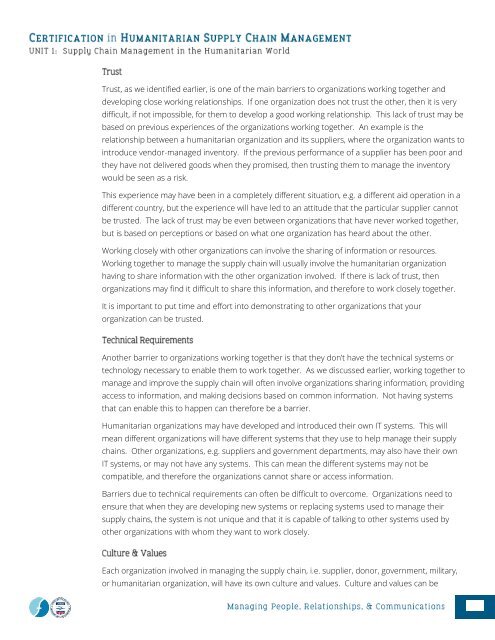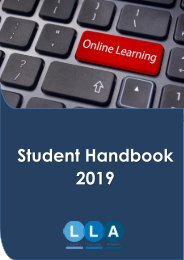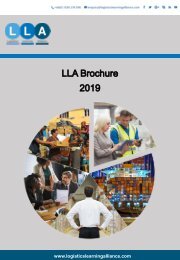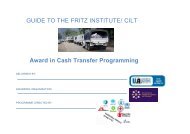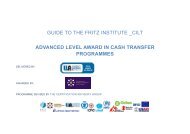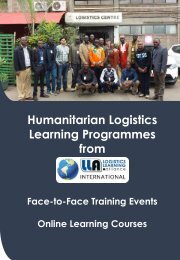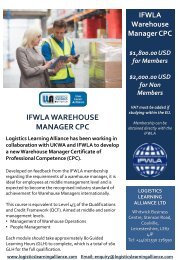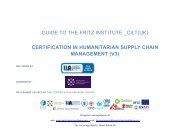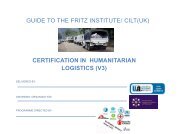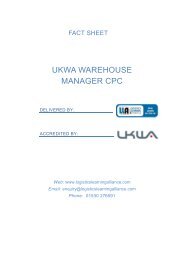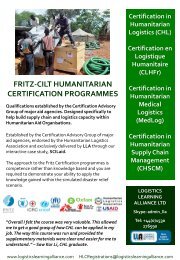CHSCM 3.0 - Unit 1 - SCM in the Humanitarian World
Learning Materials for Unit 1 of the Certification in Humanitarian Supply Chain Management (CHSCM).
Learning Materials for Unit 1 of the Certification in Humanitarian Supply Chain Management (CHSCM).
You also want an ePaper? Increase the reach of your titles
YUMPU automatically turns print PDFs into web optimized ePapers that Google loves.
Trust, as we identified earlier, is one of <strong>the</strong> ma<strong>in</strong> barriers to organizations work<strong>in</strong>g toge<strong>the</strong>r and<br />
develop<strong>in</strong>g close work<strong>in</strong>g relationships. If one organization does not trust <strong>the</strong> o<strong>the</strong>r, <strong>the</strong>n it is very<br />
difficult, if not impossible, for <strong>the</strong>m to develop a good work<strong>in</strong>g relationship. This lack of trust may be<br />
based on previous experiences of <strong>the</strong> organizations work<strong>in</strong>g toge<strong>the</strong>r. An example is <strong>the</strong><br />
relationship between a humanitarian organization and its suppliers, where <strong>the</strong> organization wants to<br />
<strong>in</strong>troduce vendor-managed <strong>in</strong>ventory. If <strong>the</strong> previous performance of a supplier has been poor and<br />
<strong>the</strong>y have not delivered goods when <strong>the</strong>y promised, <strong>the</strong>n trust<strong>in</strong>g <strong>the</strong>m to manage <strong>the</strong> <strong>in</strong>ventory<br />
would be seen as a risk.<br />
This experience may have been <strong>in</strong> a completely different situation, e.g. a different aid operation <strong>in</strong> a<br />
different country, but <strong>the</strong> experience will have led to an attitude that <strong>the</strong> particular supplier cannot<br />
be trusted. The lack of trust may be even between organizations that have never worked toge<strong>the</strong>r,<br />
but is based on perceptions or based on what one organization has heard about <strong>the</strong> o<strong>the</strong>r.<br />
Work<strong>in</strong>g closely with o<strong>the</strong>r organizations can <strong>in</strong>volve <strong>the</strong> shar<strong>in</strong>g of <strong>in</strong>formation or resources.<br />
Work<strong>in</strong>g toge<strong>the</strong>r to manage <strong>the</strong> supply cha<strong>in</strong> will usually <strong>in</strong>volve <strong>the</strong> humanitarian organization<br />
hav<strong>in</strong>g to share <strong>in</strong>formation with <strong>the</strong> o<strong>the</strong>r organization <strong>in</strong>volved. If <strong>the</strong>re is lack of trust, <strong>the</strong>n<br />
organizations may f<strong>in</strong>d it difficult to share this <strong>in</strong>formation, and <strong>the</strong>refore to work closely toge<strong>the</strong>r.<br />
It is important to put time and effort <strong>in</strong>to demonstrat<strong>in</strong>g to o<strong>the</strong>r organizations that your<br />
organization can be trusted.<br />
Ano<strong>the</strong>r barrier to organizations work<strong>in</strong>g toge<strong>the</strong>r is that <strong>the</strong>y don’t have <strong>the</strong> technical systems or<br />
technology necessary to enable <strong>the</strong>m to work toge<strong>the</strong>r. As we discussed earlier, work<strong>in</strong>g toge<strong>the</strong>r to<br />
manage and improve <strong>the</strong> supply cha<strong>in</strong> will often <strong>in</strong>volve organizations shar<strong>in</strong>g <strong>in</strong>formation, provid<strong>in</strong>g<br />
access to <strong>in</strong>formation, and mak<strong>in</strong>g decisions based on common <strong>in</strong>formation. Not hav<strong>in</strong>g systems<br />
that can enable this to happen can <strong>the</strong>refore be a barrier.<br />
<strong>Humanitarian</strong> organizations may have developed and <strong>in</strong>troduced <strong>the</strong>ir own IT systems. This will<br />
mean different organizations will have different systems that <strong>the</strong>y use to help manage <strong>the</strong>ir supply<br />
cha<strong>in</strong>s. O<strong>the</strong>r organizations, e.g. suppliers and government departments, may also have <strong>the</strong>ir own<br />
IT systems, or may not have any systems. This can mean <strong>the</strong> different systems may not be<br />
compatible, and <strong>the</strong>refore <strong>the</strong> organizations cannot share or access <strong>in</strong>formation.<br />
Barriers due to technical requirements can often be difficult to overcome. Organizations need to<br />
ensure that when <strong>the</strong>y are develop<strong>in</strong>g new systems or replac<strong>in</strong>g systems used to manage <strong>the</strong>ir<br />
supply cha<strong>in</strong>s, <strong>the</strong> system is not unique and that it is capable of talk<strong>in</strong>g to o<strong>the</strong>r systems used by<br />
o<strong>the</strong>r organizations with whom <strong>the</strong>y want to work closely.<br />
Each organization <strong>in</strong>volved <strong>in</strong> manag<strong>in</strong>g <strong>the</strong> supply cha<strong>in</strong>, i.e. supplier, donor, government, military,<br />
or humanitarian organization, will have its own culture and values. Culture and values can be


